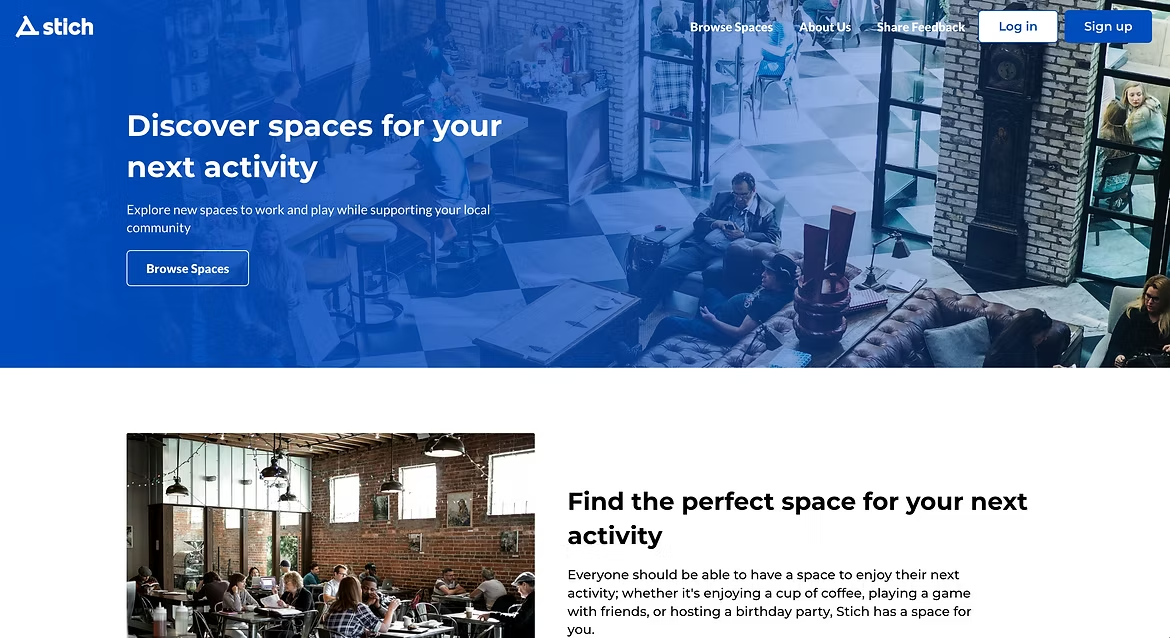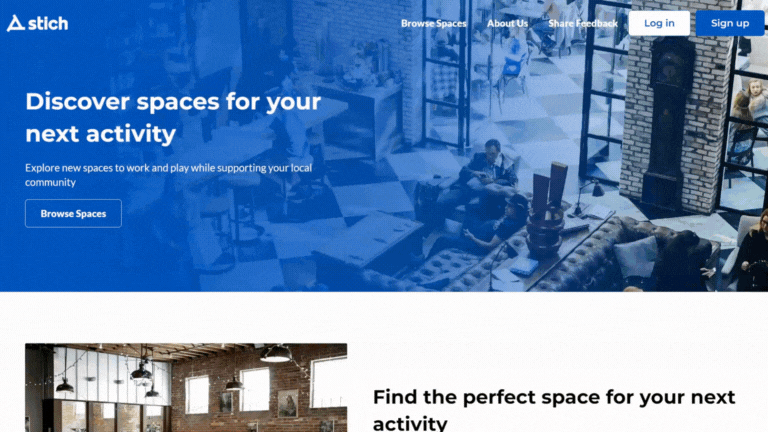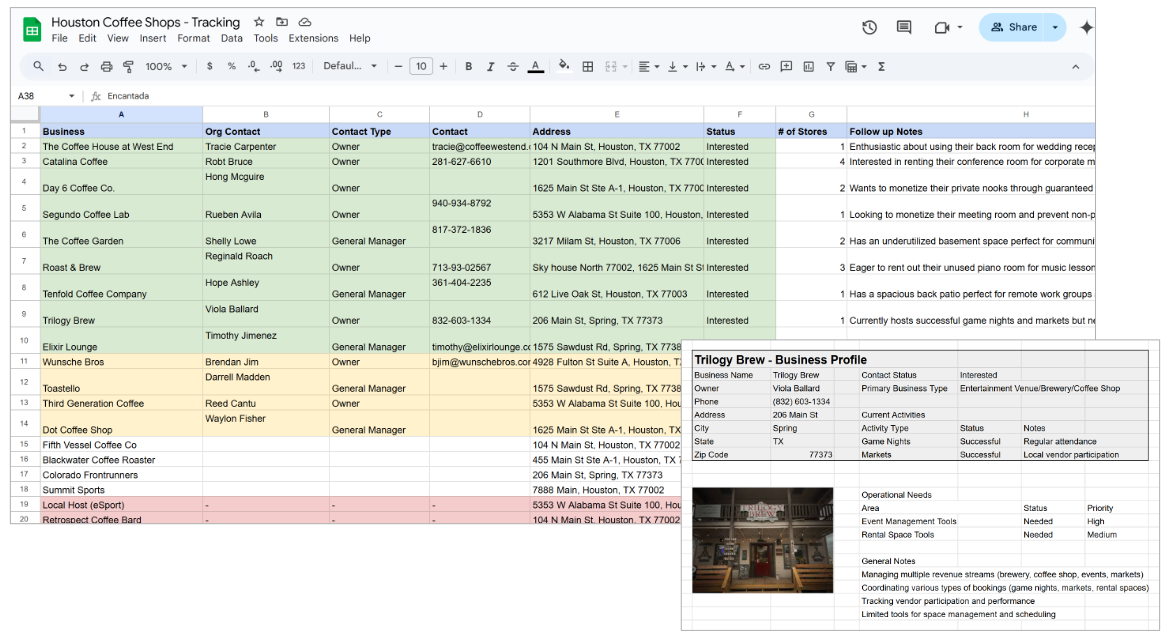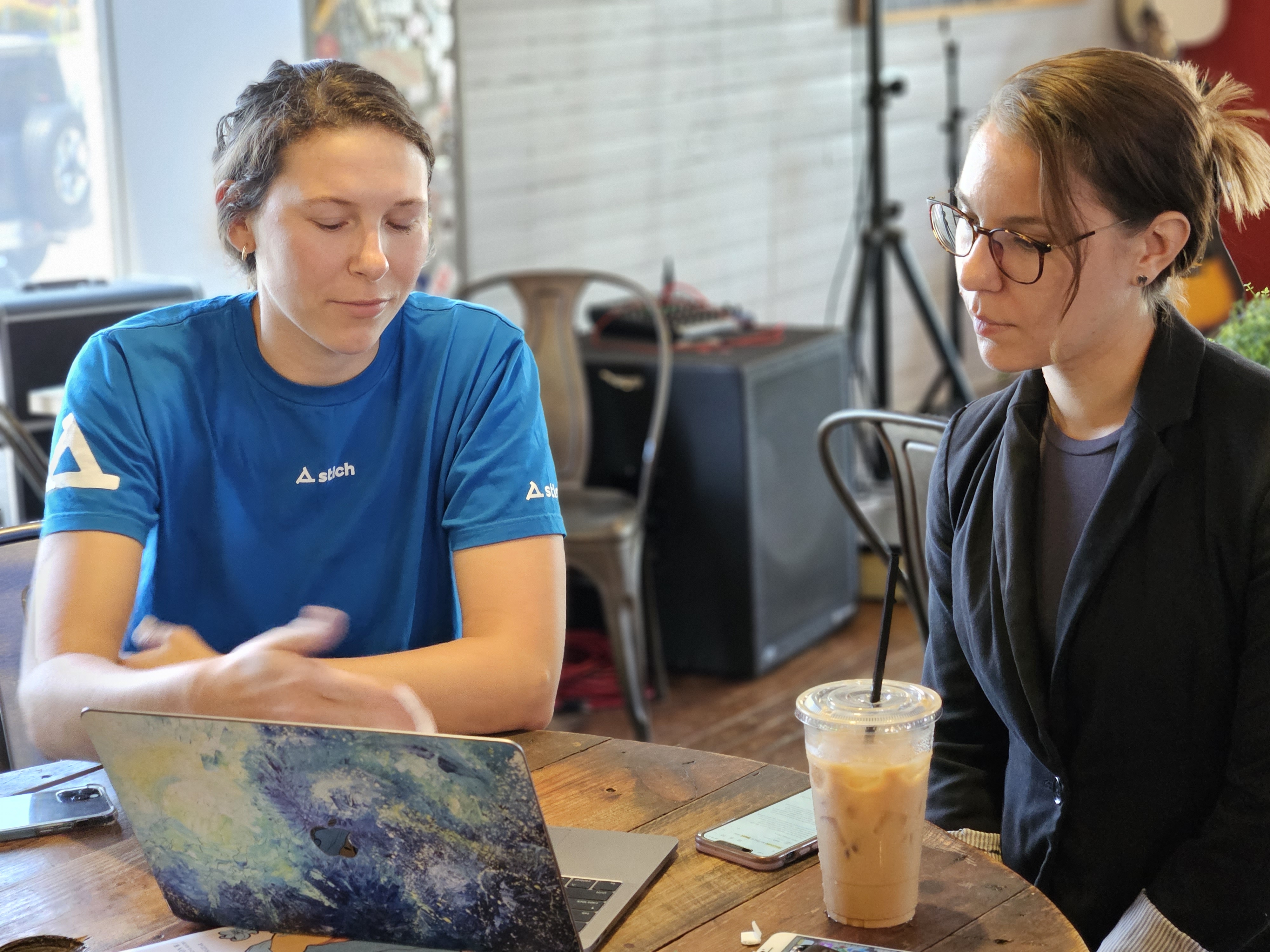Stich set out to transform how remote workers and local businesses connect through a revolutionary space reservation app. As Co-Founder and Marketing Lead, I drove the user research process and developed our brand / marketing strategy, creating a first-of-its-kind booking system that would fundamentally change how people discover and reserve workspaces while helping local businesses thrive.
Creating a flexible marketplace for rentable spaces
scroll down to view the project
My Role
Co-Founder & Marketing Lead
Team
2 Co-Founders (Including Myself)
1 UX Research (Myself)
1 UX Designer
Research & Design Timeline
6+ months (part-time outside my full-time job)

An image of the default homepage of the Stich Marketplace
The concept began as an after-hours startup focusing on connecting remote workers with local businesses.
Small businesses were struggling to diversify their revenue while remote workers kept occupying tables for hours limiting customer turnover. When we started exploring this opportunity, we saw a chance to transform how local businesses could function as flexible co-working spaces.
This project set out to solve how to seamlessly connect remote workers with local businesses through an intuitive platform, transforming coffee shops and breweries into flexible co-working spaces.

A gif showing the interaction of our marketplace beta software
How might we help small businesses offer reliable workspace reservations while creating new revenue streams?
What would make remote workers feel confident about finding and booking spaces at local businesses?
Prior solutions focused on traditional co-working spaces but lacked consideration for the unique potential of local businesses. We needed to understand both business owners' and remote workers' needs to create an effective solution.
Local businesses struggle to monetize unused space while remote workers lack reliable workspaces. The disconnect between these groups creates missed revenue opportunities for businesses and frustration for workers seeking productive environments.
Core Objectives
-
Create an intuitive marketplace connecting remote workers with local business spaces
-
Develop simple space management tools for business owners
-
Build trust through clear space/amenity information
-
Design scalable solutions that work for diverse business types
Project Stakeholders
Internal
-
Co-Founders
-
Beta Testing Businesses
External
-
Small Business Owners
-
Remote Workers
-
Cafe/Restaurant Managers
-
Local Business Communities
-
Local Residents
-

This is an image of business profiles and a datasheet I created to track businesses
What I discovered
-
Small business owners were overwhelmed with daily operations and needed simple, streamlined solutions
-
Businesses had untapped potential for additional revenue but lacked the tools to maximize their space usage
-
Current rentable platforms were too expensive and rigid for small businesses to vitalize
-
Remote workers struggled to find reliable spaces and adequate information about business amenities
What the market needed
-
A platform that would let businesses easily manage and monetize their spaces for diverse activities, from remote work to events
-
Clear, detailed information about spaces and amenities to help users find the right venue for their specific needs
-
A streamlined system for discovering and booking various spaces at local businesses, whether for work, events, or community gatherings
-
An easy way for businesses to showcase their unique spaces and capabilities beyond just tables and chairs

This is a picture of my business partner and I conducting a in-person interview with a business owner
How did we build trust with local businesses and truly understand their space utilization needs?
Presenting Partnership Approach: In-person relationship building proved essential for connecting with local businesses, after discovering that cold emails and calls weren't effective. The challenge was establishing genuine connections with busy business owners who were skeptical of new platforms.
I adapted my approach by visiting businesses before and after my day job and during weekends, allowing me to observe their spaces in action and have meaningful conversations with owners during their less busy hours. This personal touch helped us gain trust and develop deeper insights into how different spaces could be utilized throughout the day.
Design & Business Development Process
Working on a startup taught me that great product development isn't just about the platform – it's about creating a comprehensive ecosystem where branding, business relationships, and user needs come together to serve both space owners and their customers. Things I created during my time developing Stich:
-
Thorough brand development including logo design, style guide, and marketing materials
-
Creation of business tools from pitch deck to partnership tracking systems
-
Direct engagement with business owners to understand operational needs
-
Development of unique marketing assets including table toppers and space identifiers
-
Continuous refinement of approach based on real business feedback
This methodology proved particularly effective when developing our brand identity and business materials, where each iteration built upon direct feedback from local business owners and user research.

This image shows parts of the business plan, pitch deck, and brand guide for Stich
My approach to startup development centered on three core elements:
comprehensive branding
business relationship building
scalable systems
I believe successful startup development emerges from the intersection of strong brand identity, genuine business relationships, and systematic growth strategies. This belief was reinforced during my work on Stich, where each phase moved through clear stages of business outreach, partnership development, brand refinement, and continuous learning from our early adopters.
User-Centered Approach
This is a slide deck of our sales pitch to businesses
Throughout my work on Stich, I navigated several critical startup challenges.
Navigating the complexities of working with small-businesses
Designing for Diverse Business Needs
Small businesses vary widely in their space layouts and operational needs. I embraced this challenge by developing flexible branding and marketing frameworks that could adapt to different business types while maintaining consistency. When designing our partnership materials, I used a modular approach - creating versatile assets that could be customized for each business while building toward a comprehensive platform solution.
Accessing Business Owners
The busy nature of small business operations meant connecting with owners required strategic timing and persistence. I developed outreach strategies by:
-
Visiting businesses during off-peak hours to ensure quality conversations
-
Building relationships through repeated in-person interactions
-
Creating detailed profiles to understand each business's unique needs
-
Developing trust through consistent follow-up and personalized solutions
Brand Development Complexity
During the initial launch, we faced the challenge of creating a brand that would appeal to both businesses and end users. To address this, I:
-
Created a versatile visual identity system
-
Developed dual-purpose marketing materials
-
Balanced professional appeal with approachable design
-
This experience reinforced that thoughtful brand development is crucial for startup credibility
Navigating Startup Dynamics
Leading our business development and brand initiatives required careful balance of priorities. I regularly coordinated between business outreach, brand development, marketing initiatives, and partnership management, providing input on the ux designs while maintaining focus on our core mission.
What made this uniquely challenging was balancing immediate business needs and marketing goals with long-term growth targets, all while managing Stich alongside our full-time jobs.


Takeaways
Success came from turning our resource constraints into strategic advantages - each business interaction refined our approach while keeping local business needs central.
Despite creating a strong foundation in branding, partnerships, and space management that made a real difference for local businesses, I ultimately had to step away from the startup. The demands of managing Stich alongside a full-time job while dealing with health conditions taught me valuable lessons about recognizing personal limits and the true commitment startup development requires.
Businesses Contacted
Businesses Onboarded for Beta Testing
Want to see more?
I am happy to talk through my research and design work for Stich during a scheduled call.
